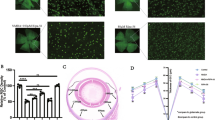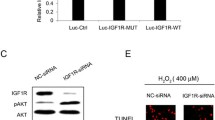Abstract
Hypoxia-induced retinal ganglion cell (RGC) death has been proposed to be the critical event in the pathophysiology of glaucoma. Therefore, delaying or halting RGC degeneration, known as neuroprotection, is a novel and promising approach with potential clinical applications for treating glaucoma. In this study, we investigate hypoxia-induced cell death of RGCs and the underlying mechanisms of N-acetylcysteine (NAC) as a neuroprotectant. To establish a model for chemical hypoxia-induced cell death, RGC-5 cells were treated with the hypoxia mimetic cobalt chloride (CoCl2). Following CoCl2 exposure, significant levels of apoptotic and autophagic cell death were observed in RGC-5 cells, evidenced by lysosome dysfunction and autophagosome formation. Pretreating RGC-5 cells with NAC significantly counteracted the autophagic cell death. NAC-mediated neuroprotection was attributed to the direct scavenging of reactive oxygen species and was mediated by targeting the hypoxia-inducible factor-1α pathway via the BNIP3 and PI3K/Akt/mTOR pathways. These results provide insights into the degeneration of RGCs and present a potential clinical application for NAC as a neuroprotectant.









Similar content being viewed by others
References
Agar A, Li S, Agarwal N, Coroneo MT, Hill MA (2006) Retinal ganglion cell line apoptosis induced by hydrostatic pressure. Brain Res 1086:191–200
Althaus J, Bernaudin M, Petit E, Toutain J, Touzani O, Rami A (2006) Expression of the gene encoding the pro-apoptotic BNIP3 protein and stimulation of hypoxia-inducible factor-1alpha (HIF-1alpha) protein following focal cerebral ischemia in rats. Neurochem Int 48:687–695
Arjamaa O, Nikinmaa M (2006) Oxygen-dependent diseases in the retina: role of hypoxia-inducible factors. Exp Eye Res 83:473–483
Azad MB, Chen Y, Henson ES, Cizeau J, McMillan-Ward E, Israels SJ, Gibson SB (2007) Hypoxia induces autophagic cell death in apoptosis-competent cells through a mechanism involving BNIP3. Autophagy 4:195–204
Bellot G, Garcia-Medina R, Gounon P, Chiche J, Roux D, Pouysségur J, Mazure NM (2009) Hypoxia-induced autophagy is mediated through hypoxia-inducible factor induction of BNIP3 and BNIP3L via their BH3 domains. Mol Cell Biol 29(10):2570–2581
Castagne V, Clarke PG (1996) Axotomy-induced retinal ganglion cell death in development: its time-course and its diminution by antioxidants. Proc Biol Sci 263:1193–1197
Chen YN, Yamada H, Mao W, Matsuyama S, Aihara M, Araie M (2007) Hypoxia-induced retinal ganglion cell death and the neuroprotective effects of beta-adrenergic antagonists. Brain Res 1148:28–37
Dahlmann-Noor AH, Vijay S, Limb GA, Khaw PT (2010) Strategies for optic nerve rescue and regeneration in glaucoma and other optic neuropathies. Drug Discov Today. 15(7–8):287–299
Denis U, Lecomte M, Paget C, Ruggiero D, Wiernsperger N, Lagarde M (2002) Advances glycation endproducts induce apoptosis of bovine retinal pericytes in culture: involvement of diacylglycerol/ceramide production and oxidative stress induction. Free Radic Biol Med 33:236–247
Dringen R, Hamprecht B (1999) N-acetylcyteine but not methionine or 2-oxothiazolidine-4-carboxylate, serves as cysteine donor for the synthesis of glutathione in cultured neurons derived from embryonic rat brain. Neurosci Lett 259:79–82
Ergorul C, Ray A, Huang W, Wang DY, Ben Y, Cantuti-Castelvetri I, Grosskreutz CL (2010) Hypoxia inducible factor-1α (HIF-1α) and some HIF-1 target genes are elevated in experimental glaucoma. J Mol Neurosci 42(2):183–191
Feke GT, Pasquale LR (2008) Retinal blood flow response to posture change in glaucoma patients compared with healthy subjects. Ophthalmology 115(2):246–252
Goldberg MA, Dunning SP, Bunn HF (1988) Regulation of the erythropoietin gene: evidence that the oxygen sensor is a heme protein. Science 242:1412–4145
Jung JY, Roh KH, Jeong YJ, Kim SH, Lee EJ, Kim MS, Oh WM, Oh HK, Kim WJ (2008) Estradiol protects PC12 cells against CoCl2-induced apoptosis. Brain Res Bull 76:579–585
Kaelin WG Jr, Ratcliffe PJ (2008) Oxygen sensing by metazoans: the central role of the HIF hydroxylase pathway. Mol Cell 30(4):393–402
Khan M, Sekhon B, Jatana M, Giri S, Gilg AG, Sekhon C, Singh I, Singh AK (2004) Administration of N-acetylcysteine after focal cerebral ischemia protects brain and reduces inflammation in a rat model of experimental stroke. J Neurosci Res. 15;76(4):519-27
Krishnamoorthy RR, Agarwal P, Prasanna G, Vopat K, Lambert W, Sheedlo HJ, Pang IH, Shade D, Wordinger RJ, Yorio T, Clark AF, Agarwal N (2001) Characterization of a transformed rat retinal ganglion cell line. Brain Res Mol Brain Res 86:1–12
Maher P, Hanneken A (2005) The molecular basis of oxidative stress induced cell death in an immortalized retinal ganglion cell line. Invest Ophthalmol Vis Sci 46:749–757
Mazure NM, Pouyssegur J (2010) Hypoxia-induced autophagy: cell death or cell survival? Curr Opin Cell Biol 22(2):177–180
McMahon LP, Yue W, Santen RJ, Lawrence JC Jr (2005) Farnesylthiosalicylic acid inhibits mammalian target of rapamycin (mTOR) activity both in cells and in vitro by promoting dissociation of the mTOR-raptor complex. Mol Endocrinol 19:175–183
Mowat FM, Luhmann UF, Smith AJ, Lange C, Duran Y, Harten S, Shukla D, Maxwell PH, Ali RR, Bainbridge JW (2010) HIF-1alpha and HIF-2alpha are differentially activated in distinct cell populations in retinal ischaemia. PLoS ONE 5:e11103
Ozdemir G, Tolun FI, Gul M, Imrek S (2009) Retinal oxidative stress induced by intraocular hypertension in rats may be ameliorated by brimonidine treatment and N-acetyl cysteine supplementation. J Glaucoma 18(9):662–665
Qu J, Wang D, Grosskreutz CL (2010) Mechanisms of retinal ganglion cell injury and defense in glaucoma. Exp Eye Res 91(1):48–53
Ritch R (2007) Natural compounds: evidence for a protective role in eye disease. Can J Ophthalmol 42:425–438
Rodríguez-Martín E, Casarejos MJ, Canals S, de Bernardo S, Mena MA (2002) Thiolic antioxidants protect from nitric oxide-induced toxicity in fetal midbrain cultures. Neuropharmacology 43(5):877–888
Tezel G (2006) Oxidative stress in glaucomatous neurodegeneration: mechanisms and consequences. Prog Retin Eye Res 25:490–513
Tezel G, Yang X, Cai J (2005) Proteomic identification of oxidatively modified retinal proteins in a chronic pressure-induced rat model of glaucoma. Invest Ophthalmol Vis Sci 46(9):3177–3187
Tulsawani R, Kelly LS, Fatma N, Chhunchha B, Kubo E, Kumar A, Singh DP (2010) Neuroprotective effect of peroxiredoxin 6 against hypoxia-induced retinal ganglion cell damage. BMC Neurosci 11:125
Vengellur A, LaPres JJ (2004) The role of hypoxia inducible factor 1α in cobalt chloride induced cell death in mouse embryonic fibroblasts. Toxicol Sci 82:638–646
Wang X, Svedin P, Nie C, Lapatto R, Zhu C, Gustavsson M, Sandberg M, Karlsson JO, Romero R, Hagberg H, Mallard C (2007) N-acetylcysteine reduces lipopolysaccharide-sensitized hypoxic-ischemic brain injury. Ann Neurol 61(3):263–271
Wu Y, Li X, Xie W, Jankovic J, Le W, Pan T (2010) Neuroprotection of deferoxamine on rotenone-induced injury via accumulation of HIF-1 alpha and induction of autophagy in SH-SY5Y cells. Neurochem Int 57(3):198–205
Yang WW, Shu B, Zhu Y, Yang HT (2008) E2F6 inhibits cobalt chloride-mimetic hypoxia-induced apoptosis through E2F1. Mol Biol Cell 19:3691–3700
Zhang H, Bosch-Marce M, Shimoda LA, Tan YS, Baek JH, Wesley JB, Gonzalez FJ, Semenza GL (2008a) Mitochondrial autophagy is an HIF-1-dependent adaptive metabolic response to hypoxia. J Biol Chem 283:10892–10903
Zhang S, Chai FY, Yan H, Guo Y, Harding JJ (2008b) Effects of NAC and glutathione ethyl ester drops on strepotzotocin-induced diabetic cataract in rats. Mol Vision 14:862–870
Zhu X, Zhou W, Cui Y, Zhu L, Li J, Xia Z, Shao B, Wang H, Chen H (2009) Muscarinic activation attenuates abnormal processing of beta-amyloid precursor protein induced by cobalt chloride-mimetic hypoxia in retinal ganglion cells. Biochem Biophys Res Commun 384(1):110–113
Zhu X, Zhou W, Cui Y, Zhu L, Li J, Feng X, Shao B, Qi H, Zheng J, Wang H, Chen H (2010) Pilocarpine protects cobalt chloride-induced apoptosis of RGC-5 cells: involvement of muscarinic receptors and HIF-1 alpha pathway. Cell Mol Neurobiol 30:427–435
Zou W, Yan M, Xu W, Huo H, Sun L, Zheng Z, Liu X (2001) Cobalt chloride induces PC12 cells apoptosis through reactive oxygen species and accompanied by AP-1 activation. J Neurosci Res 64(6):646–653
Acknowledgments
This study was supported by the National Key Basic Research Program (2010CB529800), the National Natural Science Foundation of China (No. 30472012, 30700280 and 30701018), the Shanghai Municipal Science and Technology Commission (No. 11ZR1419300), the Shanghai Municipal Education Commission (No. 12YZ037), and the Shanghai Leading Academic Discipline Project (No. S30205).
Author information
Authors and Affiliations
Corresponding authors
Additional information
Lan Yang and Panpan Tan contributed equally to this work.
Rights and permissions
About this article
Cite this article
Yang, L., Tan, P., Zhou, W. et al. N-Acetylcysteine Protects Against Hypoxia Mimetic-Induced Autophagy by Targeting the HIF-1α Pathway in Retinal Ganglion Cells. Cell Mol Neurobiol 32, 1275–1285 (2012). https://doi.org/10.1007/s10571-012-9852-0
Received:
Accepted:
Published:
Issue Date:
DOI: https://doi.org/10.1007/s10571-012-9852-0




